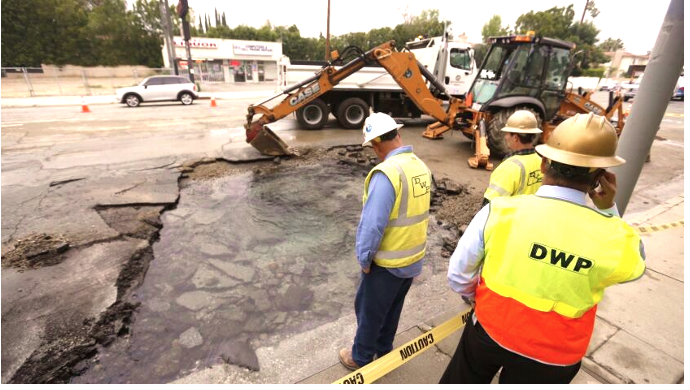CommentsPLANNING WATCH - In case you have doubts, LA’s Planning Department has assembled a long list of planning projects they worked on in 2021.
A Citywide Sign ordinance, a Collection Bin ordinance, amendments to the Cornfield-Arroyo Seco Specific Plan, a Home-Sharing Ordinance amendment, a Local Emergency Code amendment, a Mello Act ordinance, a Private Detention Centers ordinance, a Processes and Procedures Ordinance, a Restaurant Beverage Program Ordinance, a Ridgeline Protection Ordinance, a Temporary Signs on Construction Walls Code Amendment, a Transportation Demand Management Program update, a Vacation Rental Ordinance, a Ventura-Cahuenga Boulevard Corridors Specific Plan amendment, a Westwood Village Specific Plan amendment, and a Wildlife District ordinance.
In addition to these prospective ordinances, the City Council adopted three planning-related ordinances in 2021: a Cannabis Location Restriction ordinance (Adopted June 22, 2021), amendments to the Floodplain Hazards Management Specific Plan (Adopted April 14, 2021), and a Protected Tree and Shrub ordinance (Effective February 4, 2021).
But, for those skeptics who think the planning glass is nevertheless mostly empty, there are seven categories for you to ponder:
- Failure to maintain LA’s legally required General Plan. LA’s City Charter (Sections 550-558) pinpoints the Planning Department’s major task: maintaining the city’s General Furthermore, in California each city and county and is legally required to prepare and adopt a General Plan that is timely, internally consistent, and broadly monitored. In this spirit, LA’s Planning Department has posted links to its General Plan elements (chapters). Nevertheless, despite the City Charter’s and State’s requirements, nearly all of the General Plan elements are long past their expiration date. Only six Community Plans have been updated during the past 17 years. According to the City Council’s six year update rule, they must now begin their second update. Seventeen other Community Plans are in preparation, but with their schedules pushed back. Twelve remaining Community Plans and two District Plans are waiting or a start date.
As for the citywide General Plan elements, they should be updated every ten years, and these long overdue updates should be completed prior to the preparation and adoption of new Community Plans. These citywide elements include Air Quality (1992), Conservation (2001), Health (2015), Safety (1996), Mobility (2015), Infrastructure (1972), Open Space (1973), Public Facilities and Services (1969), Noise (1999), and Housing (2021). Of these, only the Housing Element is current, and its singular focus on up-zoning means it is headed for failure.
- Gaudy signs and mismatched buildings blight every Los Angeles neighborhood. The current Community Plans contain adopted – but ignored -- policies that new structures should match the character and scale of existing buildings. For example, the Wilshire Community Plan (2002) states, “Objective 2-3.: Improve streetscape identity and character through appropriate controls of signs, landscaping, and streetscape improvements; and require that new development be compatible with the scale of adjacent neighborhoods.” While excellent design guidelines are in place, they are also out-of-sight and out-of-mind.
- Under-planted or totally barren parkways and median strips. A healthy urban forest is essential for climate change mitigation and adaptation, aesthetics, mobility, and air quality. The bad news is that LA’s General Plan mostly avoids any consideration of the urban forest, and the City Council’s budget allocation for all tree-related programs is one-quarter that of comparable cities.
- Growing homelessness and homeless encampments. With around 50,000 people, including families, living in their cars or sleeping on LA’s streets, City Hall has demonstrated that its planning policies make the housing crisis worse. Its claim that even more luxury apartments will fix this inexcusable social problem is, to be charitable, ludicrous. While City Planning prepared and adopted a new 2021-2029 Housing Element at record speed, especially when compared to its creaky 50-year-old General Plan elements for infrastructure and public services, the Housing Element’s private sector approach renders it useless.
Melting into the shadows of green-lighted high-rise apartments with high vacancy rates, are LA’s ever-increasing homeless. These Angelinos desperately hope they can make it through LA’s winter without joining the 1000 people who have annually died on LA’s streets.

- Failing public infrastructure and public services. There are clear consequences for not updating the two General Plan elements that are a half-century old: infrastructure and public services. In LA it is hard to drive or bike down nearly any street without experiencing a carnival ride from the potholes. As for sidewalks cracked and lifted by tree roots, many people have given up walking in their own neighborhoods. While City crews are perpetually hard at work making repairs, they are trapped in an unwinnable game of catch-up.
- Climate change is already visible in LA as wildfires, heat waves, droughts, and floods. In LA, a short-term Mayoral executive document, LA’S Green New Deal, focuses on adapting – not preventing -- climate change. Not only is adaptation inadequate, but it also circumvents the city’s General Plan. The Green New Deal has not been subject to public workshops and hearings, reviewed for potential environmental impacts, adopted by the City Council as a General Plan element, implemented by City ordinances, and allocated funds through the City’s budget.
- Worsening traffic congestion. LA’s Mobility Element 2035 is “only” seven years old, but its successes and failures are hard to determine because it does not have a comprehensive monitoring and enforcement process. Nevertheless, based on preliminary evidence, traffic congestion is returning or even surpassing to its pre-Pandemic levels. As for siphoning off some of those driving to work, shopping, or running errands, to take transit, walk, or bike, the prospects are not good because the planning process does not actively address these non-car options. It does, however, promote new traffic-intensive buildings, such as new McMansions, shopping centers, and high rise apartment towers.
Planning is more than the regulation of private real estate ventures, what is left behind when planning departments abdicate their role in preparing, implementing, and monitoring policies for an entire city. In LA the General Plan includes citywide plans, as well as local Community Plans. What they have in common is that they address the city’s entire land area. This includes what is visible at street level, located below, and the environment in which all of the categories above reside. This means that municipal plans must address design and architecture, urban forest, housing and homelessness, infrastructure and public services, climate and environment, and mobility. When they don’t, the result is the bleak Los Angeles that we encounter every day.
(Dick Platkin is a former Los Angeles city planner who reports on local planning issues for CityWatchLA. He serves on the board of United Neighborhoods for Los Angeles (UN4LA) and co-chairs the Greater Fairfax Residents Association. Previous Planning Watch columns are available at the CityWatchLA archives. Please send questions and corrections to [email protected] .)
Sidebar
Our mission is to promote and facilitate civic engagement and neighborhood empowerment, and to hold area government and its politicians accountable.

 CityWatch Los Angeles
Politics. Perspective. Participation.
CityWatch Los Angeles
Politics. Perspective. Participation.
18
Thu, Dec















